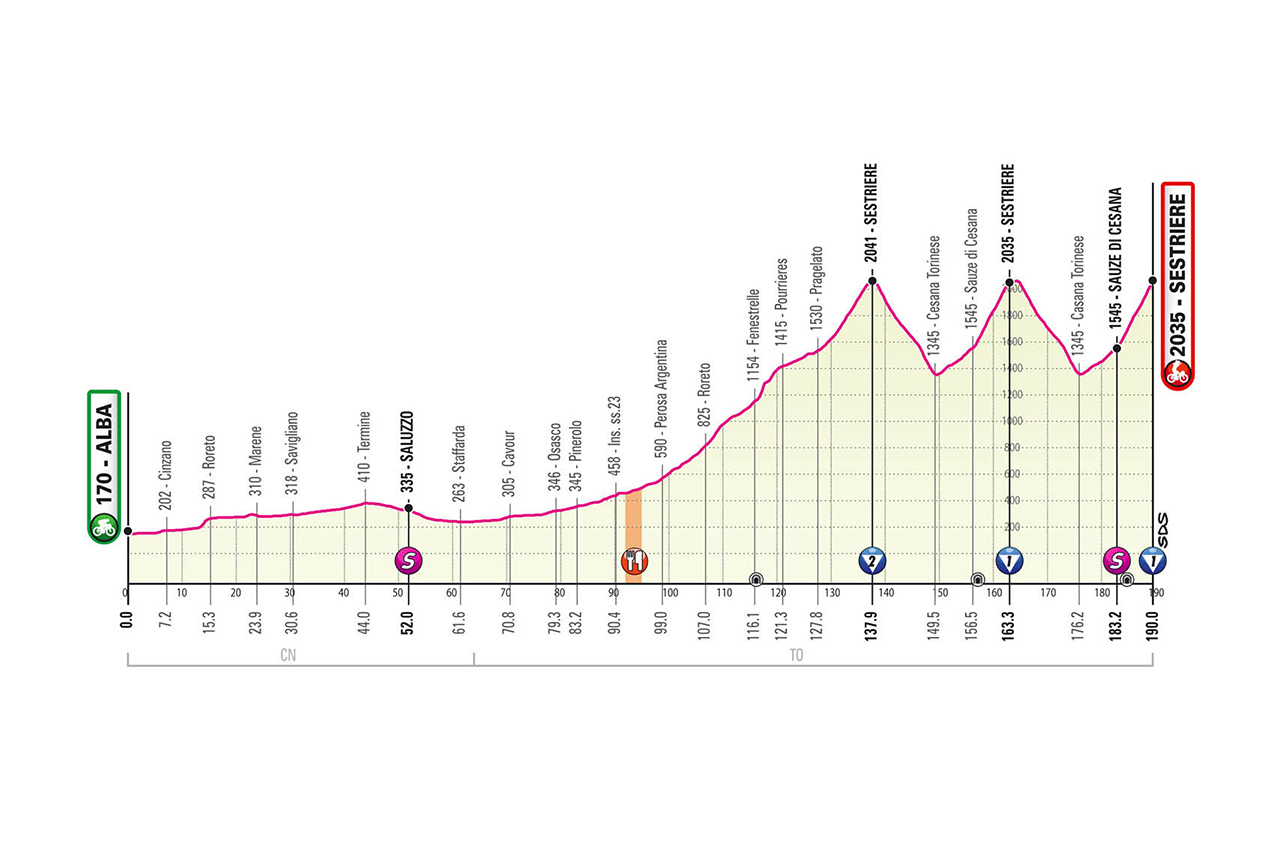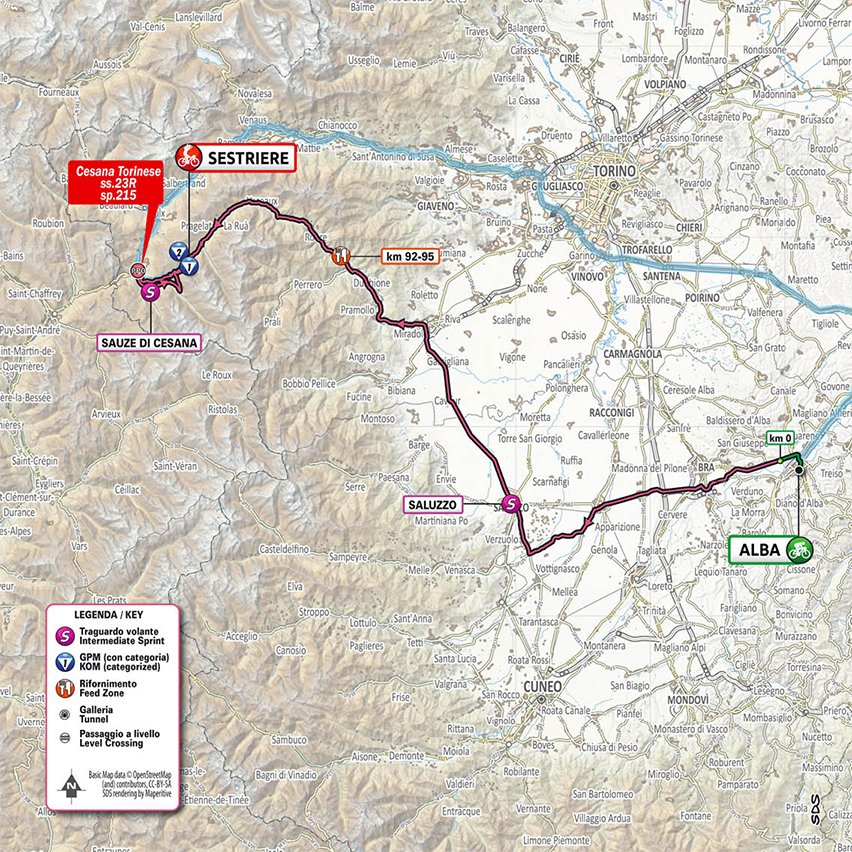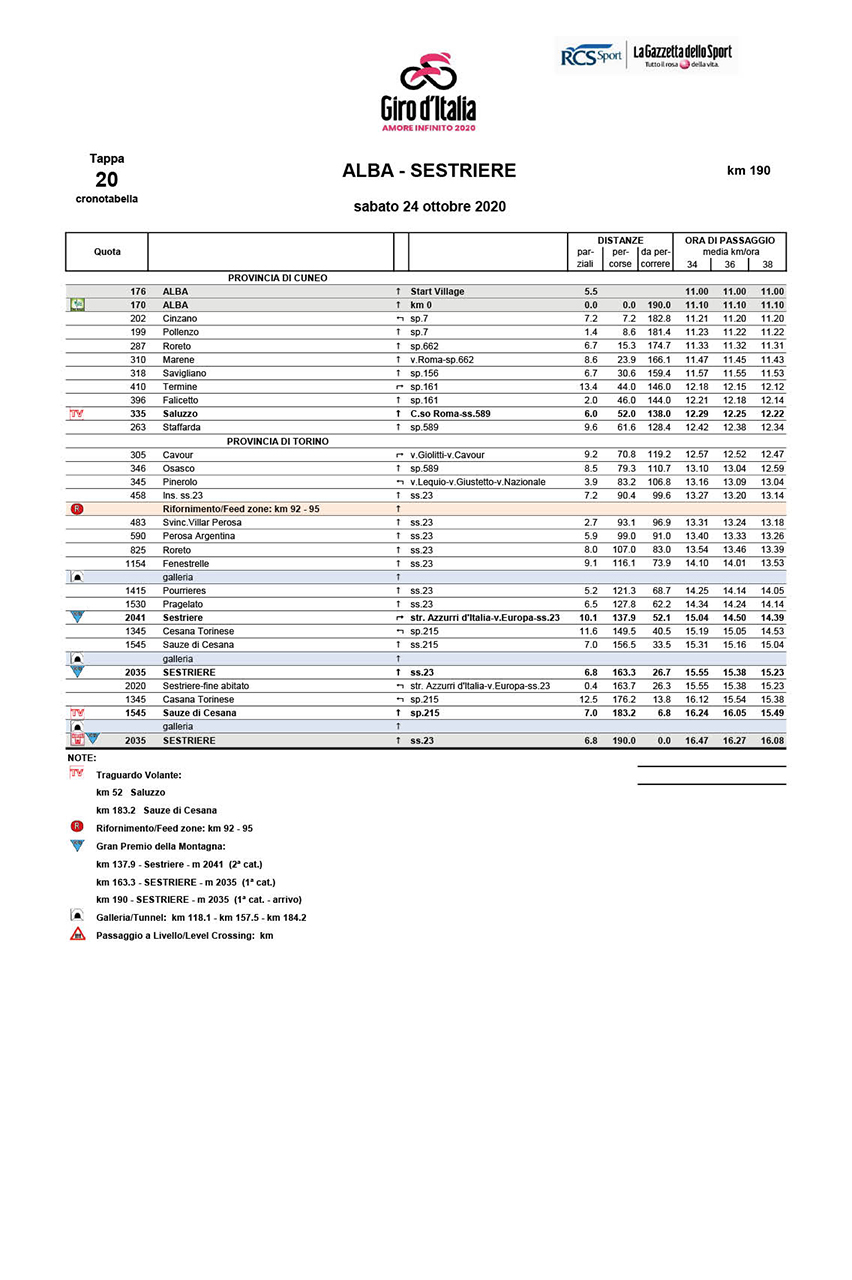profile
map
technical info
The Route
A tough stage across the Alps, with over 3,500 m vertical altitude gain. The route crosses the plain on relatively wide and straight roads, from Alba to Pinerolo. Then comes a lengthy but quite uncomplicated climb leading to the first pass in Sestriere (without crossing the finish line). After dropping into Cesana Torinese, the route bounces back to Sestriere through Sauze di Cesana and passes over the finish line, where KOM points are up for grabs. The course descends again to Cesana Torinese to take a second lap of the circuit, heading for a summit finish in Sestriere.
Final kilometres
The final kilometres are raced on the wide and well-paved sp. 215, with just a short tunnel (100 m) in Grangesises, and a small roundabout 300 m before the finish. The home straight (250 m) is on 7 m wide tarmac.
start / finish
itinerary timetable
tourist info
Host city:
Alba
Overview
Alba, Creative Cities of UNESCO, is nestled in the hills of Southern Piedmont, not far from Turin and Milan. Alba is as the “capital” of the area, the heart of the gastronomic Langhe Roero district, renowned for its excellent products, increasingly sought after as a tourist destination.
Alba is culture! You can breathe it, together with history, walking along the Romanesque and Baroque architecture of the churches, stepping on the Roman remains of “underground Alba”, discovering the Neolithic origins of the first human settlements up to the Eusebio Museum
Food
Alba is gastronomy! The city and the surroundings provide us with a rich gastronomic offer: wine cellars, wine bars, farmhouses, inns and restaurants; you just have to choose where to start your journey through the tastes and flavors of our cuisine. The Alba White Truffle is the King of the culinary world.
People coming to the Langhe Monferrato Roero region know what to expect: beautiful landscapes, excellent food&wine and high-level hospitality. Food and wine are the traditional attractions of the area; important wines, like Barolo, Barbaresco, Barbera d’Asti and Moscato d’Asti, are served with local dishes: countless starters, homemade pasta like tajarin, ravioli al “plin” and agnolotti, fassone tartare, PDO cheeses (i.e. Robiola di Roccaverano), that can be enhanced by an Alba White Truffle shave.
Last but not least, the desserts made with Nocciola Piemonte PGI, such as the hazelnut cake and the bunet (a traditional chocolate pudding to be eaten by the spoon).
Drink
Interested people and food and wine lovers can address to Piemonte On Wine® in order to book their wine tour in the wine cellars and to Piemonte On Food® to visit local producers of gastronomic specialties. www.piemonteonwine.it.
Points of interest
Wandering the streets throughout the city center, you can admire the stunning landmarks that point to all that Alba has meant throughout its history.
Beginning in Piazza Pertinace, you will see the remains of a Roman temple that dates back to the 1st century AD and which was rediscovered in 2006 when restoring the adjacent building.
Continuing along Via Cavour and before reaching Piazza Risorgimento, there are a number of buildings that were remodeled in the 1800s, including: Casa Toppino, Casa Astesiano, Casa Paruzza, and Casa Sacco.
Now we come to Piazza Risorgimento, which was once part of the Roman forum, where there was a temple dedicated to Mercury, and represented the heart of the local economy and governance.
It wasn’t until more recent times that it became a hub for Alba culture where the Italian philosopher Pietro Chiodi, from the nearby lyceum, the writer Beppe Fenoglio, who lived across the square, and the artist Pinòt Gallizio would meet. The square is also the site of the town hall, the oldest section of which dates back to the 13th century.
To the left, there is the majestic St. Lawrence Cathedral, the origins of which are unknown. First mention of the church dates back to the 12th and 13th centuries, when Alba, now a town of great importance in southwestern Piedmont, made use of the cathedral for political and administrative events.
Once known as “the City of a Hundred Towers”, Alba now only retains those that have survived war and the passing of time, most of which are in the area of Piazza Risorgimento, also known as “Piazza Duomo”. The tallest, and certainly best preserved, of these towers are Sineo, Bonino, and Astesiano. (Some twenty towers can be found throughout the historic center of town, many of which have been lowered, rebuilt, and absorbed by buildings of more recent construction.)
Continuing along Via Coppa (note the medieval Casa Cappello to the left and the tower of Casa Chiarlone to the right with its 18th-century wood door), you will come to the Church of San Domenico.
This example of Gothic architecture dates back to the second half of the 13th century.
Continuing along Via Calissano, alongside the liceo classico secondary school, we have the Teatro Sociale, restoration of which was completed in May 1997. Erected in the neoclassical style and designed by local architect Giorgio Busca, the theater was inaugurated in November 1855. It is now a unique structure in Italy, with its historical, horseshoe-shaped hall facing the new hall, both of which share a single stage.
Returning to the main thoroughfare, Via Vittorio Emanuele, also known as the “Via Maestra”, you will find a wealth of lovely shops featuring both Italian fashion and local culinary delicacies.
Along the way, you will also find the Cortile della Maddalena, which hosts the international White Alba Truffle Trade Show, the world’s premier event dedicated to this culinary treasure, as well as the World Truffle Market, which offers up truffles from all over the Langhe, Roero and Monferrato hills.
Also within this courtyard there is the Federico Eusebio Civic Museum of local archeological and natural history, featuring the remains of a mastodon and of a whale, as well as the Diocesan Museum, the Beppe Fenoglio Center, and the Churches of San Domenico and San Giuseppe. This is also the last stop on the Alba Sotterranea (“Alba Underground”) guided tour, an itinerary led by an archeologist who takes visitors to three of the 32 stops along the city’s archeology tour.
Situated in one of the most interesting points in the historic center of Alba, the Church of San Giuseppe was erected in 1643 by order of the Confraternity of Pilgrims. Completed in 1653, consecrated in 1656 and dedicated to the organization’s patron saint, the church was erected on the site of a private residence and includes both Roman features, in the cavea of the ancient theater, and medieval influences. The church also houses a stunning, 18th-century organ built by the Concone brothers, from Turin.
Sestriere
Overview
Summit of the Piedmont Olympic mountains and the Vialattea ski area, from the height of 2,035 meters, the Municipality of Sestriere is located on the homonymous hill straddling the Val Chisone and the Valle di Susa. It is dominated to the northwest by Mount Fraiteve (2,701 m), to the southeast by Mount Sises (2,658 m), Punta Rognosa di Sestriere (3,280 m) and Mount Motta (2,850 m). Sestriere is a renowned and safe point of reference for national and international tourism also thanks to the image it has been able to conquer over the years by successfully hosting major sporting events. From the Ski World Cup, to the 1997 World Ski Championships, to the Turin 2006 Winter Olympics and Paralympics: Sestriere is the ski resort that has hosted the largest number of internationally titled races.
It is also in the legend of great cycling as an alpine location that hosted the arrival of legendary stages of the Giro d’Italia.
Food
Simple or refined, strong or delicate, the flavors of our mountains are an integral part of a stay. In fact, the local gastronomic tradition is perfectly combined with selected cards of the best wines of Italy. From the most popular to the most renowned labels to accompany delicious dishes.
Points of interest
The origins of Sestriere are very recent: the town was built by royal decree on 18 October 1934. During the 1930s the first tourist settlements were built including the two characteristic towers that symbolize the hill. Sestriere consists of four residential units: Sestriere Colle, Sestriere Borgata, Champlas du Col and Champlas Janvier.
Top video

Highlights

































































































